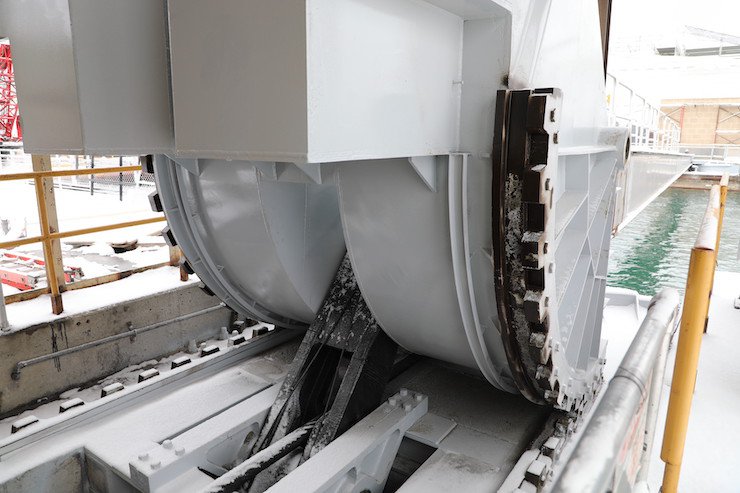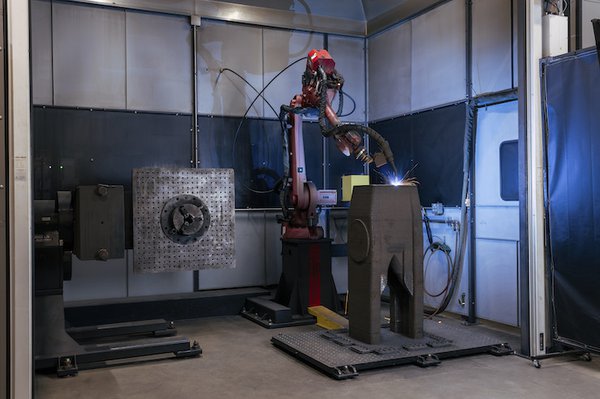US Army Corps & Lincoln Electric produce 12-foot-long ship arrestor system part with metal 3D printing
View Source
US Army Corps
The US Army Corps of Engineers (USACE) has deployed wire-arc additive manufacturing to produce a 12-foot-long metal part for the ship arrestor system.
Installed on the Poe Lock, one of the two active locks on the Soo Locks facility, the part has been described as the largest US civil works infrastructure component to be manufactured with 3D printing. Soo Locks is a set of parallel locks operated and maintained by the USACE that enable ships to travel between Lake Superior and the lower Great Lakes, with Poe Lock considered a major transit point for domestic iron ore.
Additive manufacturing was used to produce the part after a rehabilitation process identified cracks in one of the 60-year-old lever arms used to raise and lower a large boom on the Poe Lock’s arresting system. These cracks were found in February 2023, with temporary repairs being made to put the arresting system back into service for the 2023 navigation season. But during this year’s ten-week winter maintenance cycle at Soo Locks, the US Army Corps needed a new replacement part to ensure the long-term future use of what is a ‘critical-safety component’, such is its role to protect the lock’s miter gates from an emergency impact with a ship.
Having decided that additive manufacturing was the best option, the USACE awarded the contract for the lever arms to Lincoln Electric. USACE Detroit District engineers designed the arms and then worked with Lincoln Electric to determine the best print strategy to mitigate distortion, achieve the desired surface finish and material properties, and ensure adequate quality control. Together, they decided to additively manufacture the component in two pieces – the first weighing approximately 4,000 pounds and the other weighing 2,000 – using high-strength, low-alloy steel. The two pieces were later welded together at Lincoln Electric’s Baker Industries facility in Detroit, while machining was carried out by Fulton Iron and coating by Coatings Unlimited. The part was turned around in 12 weeks – compared to a projected 18-month lead time with conventional techniques – with the Soo Locks reopening for the navigation season on March 22, 2024.

US Army Corps/Lincoln Electric
“We secure our nation and energise our economy by operating, maintaining and preserving strategic water resources and infrastructure,” commented Lt. Col. Brett Boyle, Commander of the USACE Detroit District. “That is a challenge as our infrastructure continues to age. These challenges are opportunities to deliver our programme in new, innovative ways that make us more efficient. The Poe Lock ship arrestor project has been one such opportunity for our team to work with ERDC (US Army Engineer Research and Development Center) researchers to harness existing 3D printing technology in a way that safely delivered superior quality, while cutting through the extended lead times of today’s environment.”
The replacement of large vintage components is becoming a more frequent need for the USACE, with advances in additive manufacturing said to offer ‘transformative potential.’ The US ERDC has therefore commenced extensive studies on how the technology can be used by the US Army and Department of Defence to modernise USACE infrastructure components and structures. To this end, the organisation has been working with Eaton to carry out additive manufacturing research, which has led to the Poe Lock arrestor arm project and will lead to the development of a digital USACE parts inventory designed to accelerate the turnaround time for replacement parts.
Subsequent research will also focus on the production of stainless-steel materials, multi-material capability, and design optimisation.
“We found the researchers and industry partners shared our passion for solving problems in the field,” offered Peter Dodgion, chief of the USACE asset management branch. “Our field folks in Civil Works know where the problems with fabrication are. All we had to do was connect those researchers with our folks in the field and real-world solutions began to emerge.”
“This technology not only strengthens our national infrastructure, but also reinforces how the power of the collaboration is shaping the future of manufacturing and enabling the safety and efficiency of critical infrastructure," added Eaton Director of Government Programs Bryan Farrens.

